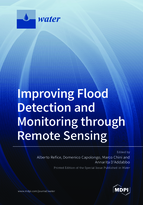Improving Flood Detection and Monitoring through Remote Sensing
A special issue of Water (ISSN 2073-4441). This special issue belongs to the section "Hydrology".
Deadline for manuscript submissions: closed (30 April 2021) | Viewed by 34234
Special Issue Editors
Interests: remote sensing data processing applied to environmental monitoring; synthetic aperture radar interferometry; persistent scatterer interferometry; flood monitoring; geomorphological terrain analysis
Special Issues, Collections and Topics in MDPI journals
Interests: GIS; remote sensing; landslides; floods; geomorphology
Interests: flood mapping; earthquakes damage detection; analysis of multitemporal data; classification; feature extraction; data fusion; segmentation; SAR and optical data; SAR interferometry
Special Issues, Collections and Topics in MDPI journals
Interests: artificial intelligence; machine learning
Special Issues, Collections and Topics in MDPI journals
Special Issue Information
Dear Colleagues,
Measures to increase defenses against floods and reduce flood damages are more and more urgent, as floods are emerging as one of the most frequent and incisive disasters due to climate change. Gaining sufficient knowledge about the extent, duration, and more generally, time evolution of flood events is a necessary step toward this goal. This information can be used to draw maps of expected return periods for events of a certain magnitude.
Remote sensing is traditionally recognized as one of the most cost-effective technologies to gain detailed information about large areas of the earth surface. Its use in the monitoring of floods and inundations dates back to the first sensors and algorithms. In recent years, the wider availability of images from both radar and optical sensors, their low to null cost, and their tight and reliable acquisition schedules are opening the path to unprecedented levels of detail about inundation events, both on urbanized and remote areas.
Nevertheless, the new, higher monitoring capabilities of such imaging devices raise new challenges connected to image interpretation, in terms of discerning effectively the presence of floodwaters in different land-cover types and environmental conditions. In this sense, high expectations come from new methods that integrate the information obtained from multiple techniques, platforms, sensors, bands, and acquisition times. Moreover, the assessment of such techniques strongly benefits from the synergy with hydrological and/or hydraulic modeling of the evolution of flood events.
Much work is being done to devise effective methodologies to reach these ambitious goals, involving very heterogeneous knowledge bases and research fields, from advanced methods for image analysis and change detection, through data fusion (also recurring to the increasingly ubiquitous paradigms of artificial intelligence, deep learning, and big data analysis), to more applied fields such as geomorphological terrain analysis, hydrological and hydraulic modeling, and data assimilation methods.
The present Special Issue welcomes contributions to this varied body of research on, but not exclusively, the following topics:
- flood monitoring through remote sensing data: experiences at all spatial scales and validations;
- data fusion, change detection, scene understanding techniques applied to multi-source remote sensing, in situ/geographic data, models, etc., for flood mapping and/or monitoring;
- assimilation of remotely sensed information within hydraulic or hydrological models;
- remote sensing data integration in flood hazard, vulnerability, risk zonation procedures.
Dr. Marco Chini
Prof. Domenico Capolongo
Dr. Alberto Refice
Dr. Annarita D’Addabbo
Guest Editors
Manuscript Submission Information
Manuscripts should be submitted online at www.mdpi.com by registering and logging in to this website. Once you are registered, click here to go to the submission form. Manuscripts can be submitted until the deadline. All submissions that pass pre-check are peer-reviewed. Accepted papers will be published continuously in the journal (as soon as accepted) and will be listed together on the special issue website. Research articles, review articles as well as short communications are invited. For planned papers, a title and short abstract (about 100 words) can be sent to the Editorial Office for announcement on this website.
Submitted manuscripts should not have been published previously, nor be under consideration for publication elsewhere (except conference proceedings papers). All manuscripts are thoroughly refereed through a single-blind peer-review process. A guide for authors and other relevant information for submission of manuscripts is available on the Instructions for Authors page. Water is an international peer-reviewed open access semimonthly journal published by MDPI.
Please visit the Instructions for Authors page before submitting a manuscript. The Article Processing Charge (APC) for publication in this open access journal is 2600 CHF (Swiss Francs). Submitted papers should be well formatted and use good English. Authors may use MDPI's English editing service prior to publication or during author revisions.
Keywords
- Flood monitoring
- Change detection
- Remote sensing data fusion and/or integration
- Data assimilation
- Hydrological and hydraulic models
- Multi-temporal, multi-sensor image analysis
- Flood hazard zonation







